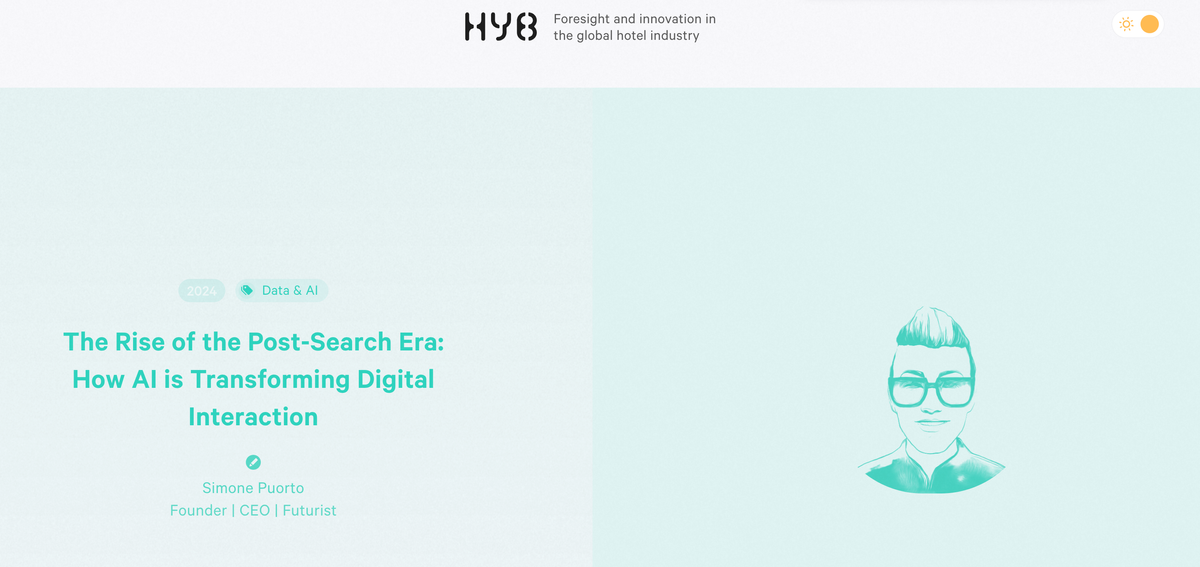The post search world of Conversational AI

I very much enjoyed this article by Simone Puorto at The Hotel Yearbook. It's titled The Rise of The Post Search Era and How AI is Transforming Digital Interaction.
Here's a brief paragraph:
If today we open a thousand browsers and apps, tomorrow we will open a single conversational platform. The practice of sifting through a multitude of websites and applications is, in hindsight, only a convention born out of necessity and, therefore, not immutable, we know that.
Let's explore this.
Simone is putting into words what many of us are thinking – or perhaps feeling.
For example, I've deliberately added ChatGPT, Pi and Perpexity AI apps to the home screen of my phone, because, more often than not, I'm asking them, rather than opening Google.
I still Google. Just, I am a lot more considerate to what I ask an AI versus Google.
I want to type.
In fact, I want to just speak.
It's quicker.
Here's a case in point. This morning, my daughter (age 7) asked me about the difference between warm and cold-blooded animals. I attempted to explain, then thought I should give her a qualified answer, on the basis that she was genuinely curious.
I opened Pi and asked it to give me a 7-year old explanation. It was sadly offline for some reason. That's the first time I've ever experienced that.
Then I asked ChatGPT. Within a second I had a proper answer which I narrated to her and then went on to discuss some more aspects with her.
Simone, though, has a point.
Increasingly I don't want to be – as she puts it – sifting through a multitude of websites and applications.
I just want it done.
And this, then, is the fundamental challenge a lot of companies are facing.
How do you serve customers in an age where there is so much digital lethargy?
For the longest time, I have found that I can't be bothered to open online banking. Sometimes you still are required to do so in order to use particular functions that still haven't been moved to mobile.
The cognitive headache of having to go and look up my 16-digit customer number and the various different PIN and password details means I really have to want to do it.
Or I need to be in front of a desktop.
At many banks, this desktop mentality is still incredibly pervasive. The assumption that all of your customers even have a desktop is – in many markets – absolutely false.
One bank I advised recently did some research and found that somewhere north of 70-odd-percent of their customers didn't even own a desktop or laptop computer.
I found that crazy. Surely not? But you absolutely can't be using your own assumptions in this reality.
Despite almost 80% of retail banking customers not owning a desktop/laptop, the bank still pays around $15M a year for its online banking systems - the web version - to operate.
Why?
The Head of Retail is of the opinion that customers still want it, despite hardly any of that 20-ish per cent of desktop-owning customers ever logging in. Most of the regular users of the web banking service were actually employees of the bank!
In today's world, so much is done on mobile. So much of life is lived on the mobile, often along with a tablet.
When it comes to looking at what people are doing on their mobile, messaging and social activity will invariably be very high up that list of daily use cases.
Which brings us back to Conversational AI.
I think we'll see more and more financial institutions move to placing their Conversational AI front-and-centre of their mobile app experience.
They'll use the bot to help customers get the boring stuff done. But increasingly, I think we'll see the introduction of systems that will actively suggest ideas and offer (basic) advice. I can imagine getting push notifications from the bank's chatbot – my own 'agent' – to remind me that I've had £5,000+ in my current account for more than 10 days and do I want to sweep £4,000 of that into Savings until I need it? And so on.
Some Financial Services companies are incredibly advanced with their Conversational AI activities already. Most notably, some Nordic and some US institutions have integrated dozens of (sometimes well over 60) different systems into their Conversational AI, meaning it can orchestrate and fulfil almost every basic service request instantly and easily.
These institutions are already exploring what they consider to be the next frontier - active outreach Conversational AI. It's there when you need anything, but it will also aim to begin engaging with you – somewhat similar to what we see with the likes of Robinhood's recent Pluto acquisition.
Some institutions I'm working with are already discussing the question... almost akin to uttering the phrase Voldemort in the world of Harry Potter.
The question, for avoidance of doubt, is when should we expand our services directly into WhatsApp? (Or any other similar platform - TikTok, Instagram, et al.)
When should "NatWest" or "Wells Fargo" simply be referenced, experienced and interfaced primarily through a chat on in your WhatsApp?
Such a question is not looked upon positively by most bank executives, especially when their cost-to-income rations are bulked out by the millions (or hundreds of millions) they need to pay to maintain their own channels.
At the moment, the quick answer that works is security. We can't possibly. It canny be done. "Security and all that". This is a good short-term, convenient response. Yes, there are serious security and confidentiality issues to consider. But, like I say, only in the short term. I think we'll see more and more pressure from customers to avoid having to open their financial services apps unless they absolutely have to.
How long before we see Financial Services apps turn into the "online" websites of today?
How long before we see a Financial Services player launch and operate only via Conversational AI? There was one. It was a European player if memory serves. Who was it? I can't remember. It was absolutely fascinating. I'll try and dig their name out.
If you haven't quite got serious about your Conversational AI strategy, I think you're ok.
It's ok today.
It's fine to be behind.
Or, put another way, you're not behind yet. Others are certainly a lot more advanced on the journey. But you're not behind yet.
What should you be doing?
Experimenting.
You should absolutely, positively be playing with the technology.
You should be deploying some Conversational AI capabilities for your Financial Services player. Absolutely. You should be testing, learning, exploring – right now.
There are some great vendors out there to be talking with. Many of them – Boost.ai for example – will get you live and operational with the basics in just a few weeks. PolyAI will (they claim) cut your call centre volume by 50% in 6 weeks using their Conversational (voice) AI offering. (Other vendors are available!)
Start the conversations. Get some proof-of-concepts operating. Look at the results carefully and then get the team to begin creating your Conversational AI strategy.
Be careful who you give this to, though. Be careful who you assign it to. Give it to the wrong team and your Conversational AI strategy will be smothered at birth. The good old tensions are on display in many companies already when it comes to Conversational AI vs mobile, for example. You'll sometimes find (for example) the Conversational AI teams struggling to get access to APIs and connectivity because the Head of Mobile doesn't want them stealing traffic and 'success' from their platform.
If you need any help with this, let me know. Whether it's independent advice, some perspective on what best-in-class looks like today or perhaps a diagnosis of where you are today and some possible next steps. I've been doing a lot of work in and around the space so please drop me a note and let's discuss possibilities.




